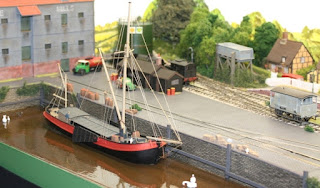An annual exhibition organised by the South West local group.
Part 3
Heybridge
Wharf
A 50 Something
challenge 3mm scale 14.2mm gauge layout by Mike Corp of the Bristol/Avon group.
Heybridge Wharf is purely fictitious and is situated somewhere
in Suffolk as
one of the last inland wharfs still operating. The railway was built under the
Light Railways Act as the Hey Light Railway to connect the town of Heybridge to the Great Eastern Main Line via Heybridge Wharf.
The trains from the main line enter Heybridge Wharf via the line between the Church
and the gas works. This is the end of the line for the stock not allowed to
proceed along the tramway to Heybridge
Town.
Those that are
allowed will run round their train and proceed along the tramway squeezed
between the gas works and Colly Tobbold's brewery. The wharf receives one of
the last barges still trading, but now converted with a diesel engine.
The layout is built of plywood with 3mm
Society 14.2mm gauge track and the pointwork from 3SMR. Points are operated by
Hoffmann stall point motors and couplings are adapted B&B.
Rolling stock is from Finney & Smith (who are now no longer trading), Worsley Works and the 3mm Society. Whilst some of the buildings are scratch built, most are super-detailed Bilteezi card kits.
Rolling stock is from Finney & Smith (who are now no longer trading), Worsley Works and the 3mm Society. Whilst some of the buildings are scratch built, most are super-detailed Bilteezi card kits.
Dunkton Combe
A Great Western 3mm scale 12mm gauge layout presented by
Richard Pope of the North Wilts Group.
History: The line ran from Limpley Stoke, on
the Bath - Westbury line, to Hallatrow on the Bristol - Frome line.
In real life, the line closed to passengers
in 1925. The section from Hallatrow to Camerton closed completely in 1932 after
all the local rail-served collieries were worked out. A service of one coal
train a day, also carrying small amounts of other local goods, continued from
Limpley Stoke until the Camerton Colliery closed in 1950. The remaining goods
service to the school and mill at Monkton Combe ended in 1951.
In our imaginary world, the last 6 miles between the junction at
Limpley Stoke and Dunkerton have remained open into the mid-1950s, with a basic
service of 5 passenger and one goods train per day on weekdays and Saturdays. There
is normally no service on Sunday but you may see a ballast train arrive, run
round and depart again to work further back along the line. Passengers are
mainly workers at the nearby mill (owned by T R Freeman & Sons and
producing flock for filling matresses) and day boys at the public school. The
mill and school also account for most of the goods traffic.
Bob Brown, who built this layout, named the
station "Dunkton Combe", as a compromise between Dunkerton and
Monkton Combe. It is not an accurate
model of either station, though both had a station building similar to the one
modelled by Bob
With so few trains on the line, it is worked
as "one engine in steam". There are no signals or signal boxes and
all points are worked by hand. There is no loco shed at the terminus, nor any
facility for watering locos. Train movements are adapted from the February 1912
timetable.
Ashbrooke
A Midland
& South Western Junction Railway (MSWJR) 3mm scale 12mm gague layout by John Thomas of the North Wilts &
Gloucester group.
This layout represents a double track
through station loosely based on Foss Cross on the Midland & South Western
Junction Railway (MSWJR). The concept is that the MSWJR continued as a
secondary route through the Cotswolds despite the Great Western Railway's
endeavours to rationalise it. You can legitimately run though trains from the
LMS in the north and the Southern Railway in the south, as well as a wide
variety of Great Western types and (in the later period) Midland and Southern
Region as well as the local Western Region and British Railways stock.
John's aim in building the layout was to
depict trains passing a wayside station, with all passenger trains calling at
the station and the occasional goods or local passenger train stopping to
shunt.
This layout is unusual in having a
fiddleyard at each end with a model of a through station in the middle. The
buildings are based on prototypes from the Cotswolds. John's scratch-built
models contribute to the unique and convincing appearance of the layout.
Further layouts to follow in Part 3...
























No comments:
Post a Comment